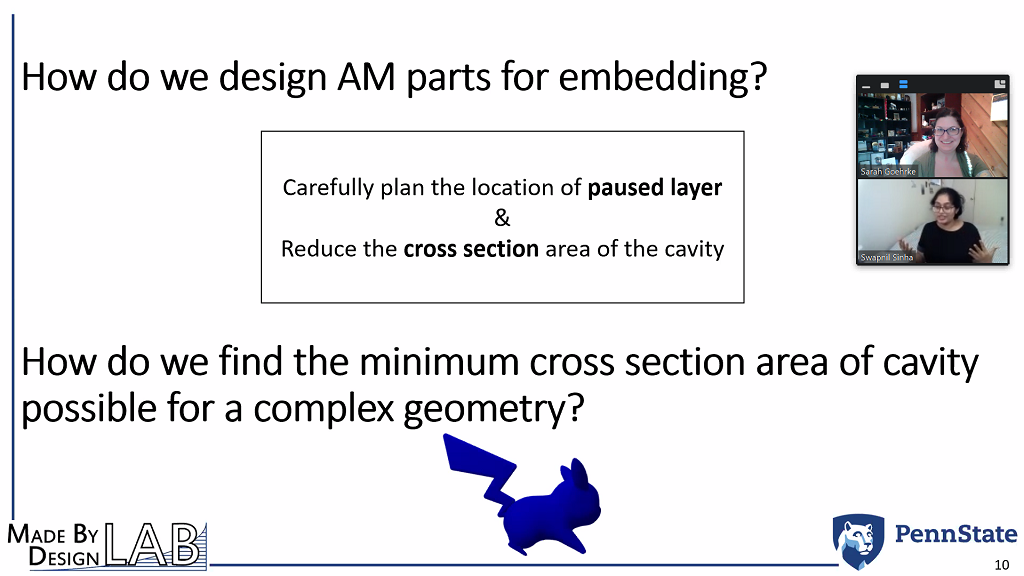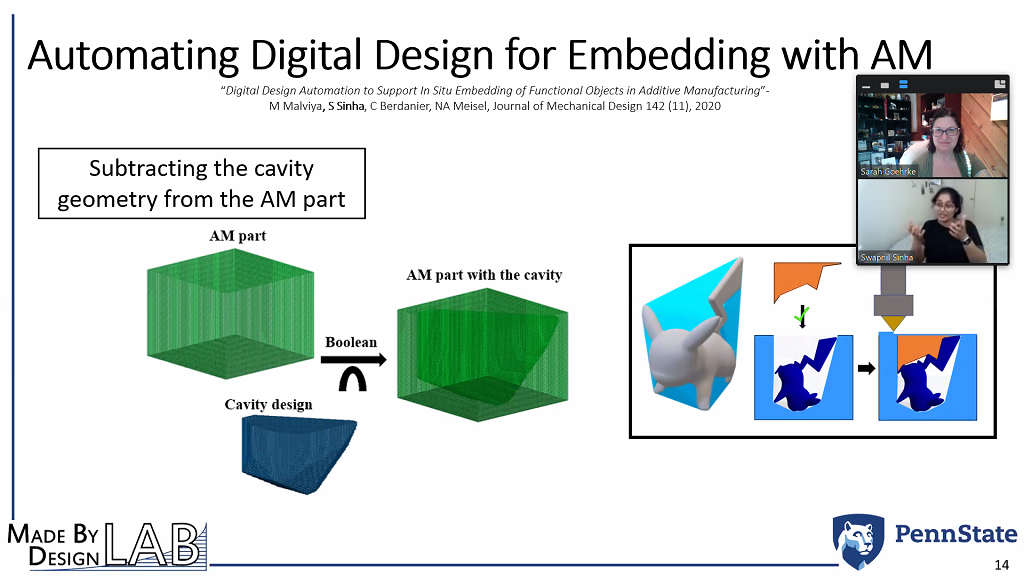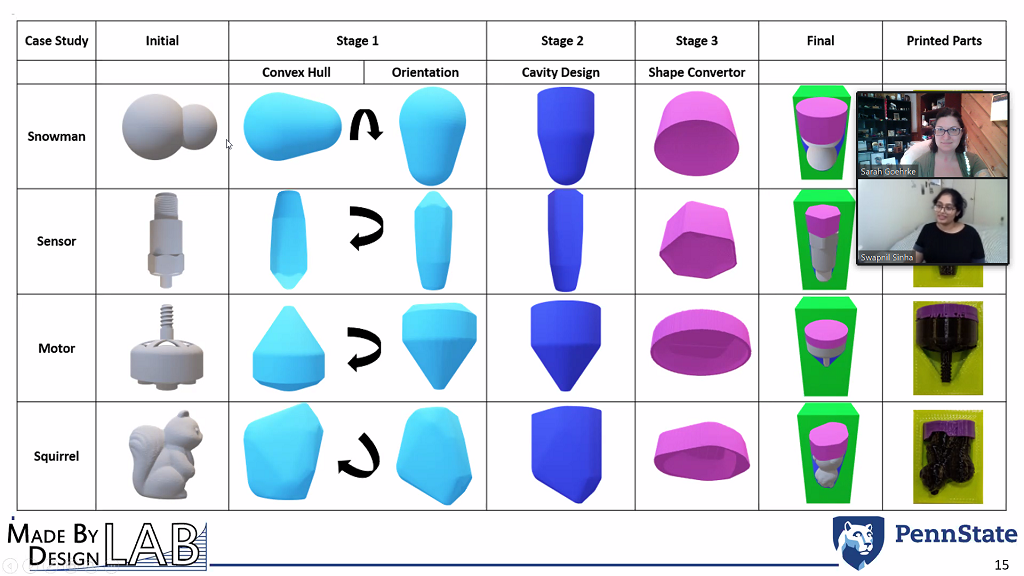
Swapnil Sinha is a PhD candidate in Mechanical Engineering at The Pennsylvania State University whose research in additive manufacturing shows strength for the future of both DfAM and in-situ embedding in 3D printed parts.
In part one of our interview, Swapnil and I discussed her journey into additive manufacturing. The path from making at home to inspiration from a Swiss watch to undergrad in India with an introduction to 3D printing to studying at Penn State for both her Master’s and PhD is one that is both inspiring and becoming a bit more familiar in this industry.
Intentionally moving toward a career path in industrial 3D printing is a road paved with different areas of research — and in Swapnil’s case, that research is both promising and functional.
In-Situ Embedding Into 3D Printed Parts
Many products these days are “smart” — or at least electronic.
Phones, remote controls, watches, headphones; many of the devices we all increasingly rely on day to day have some need for internal components. When it comes to product design, many considerations thus must come into play — the biggest of which may well be how to integrate internal components easily into a streamlined design without adding too much bulk or weight, but keeping full functionality intact.
“In-situ embedding allows insertion of functional components in the AM part,” Swapnil said to quickly sum up her area of focus.
As we’ve seen in many cases before, a 3D print job can simply be paused to insert a functional part (think electronics or even just rattling objects into a toy). The print job, once resumed, will then enclose the cavity.
However, as Swapnil noted in the first part of our chat, changing one parameter in 3D printing changes everything.
“If you change the shape or orientation, you have to have different design concentrations,” she said. “The embedding process impacts the material properties of a part due to that process interruption. Something paused will have a weaker strength, impacting how the parts cool down. That was what I got interested in.”

Extrusion-based 3D printing works by, well, extruding material. That material is melted enough to move through the hot end of a 3D printer to be extruded in a specified design. Once deposited, it retains enough structural integrity to stay in place and cools to solidify as a structure. The rate at which it cools comes into play for the adhesion between layers and ultimate strength of the part. Changing that cooling rate — by, for example, pausing the print long enough to add something in the middle of it — alters the structural integrity of the final part.
But by how much?
“This can impact part strength and quality; I am looking at where it fails, at what microstructure level that happens. How is a part built?” Swapnil has to ask the basic questions to get to the bottom of the more advanced answers.
By establishing a temperature-time diagram of the print process, her research on cavity designs offers insights into “really unique kinds of sensors.”
The video she initially shared comes into play here:
Swapnil worked to understand how different cavity structures and shapes affect the 3D printing process and its results when embedding sensors. It certainly helps when the cavity itself is optimized; it should be as small as possible to house the necessary electronics.
So Swapnil worked to automate this process. In working with different geometries — like a delightful Pikachu shape — she found a way to “gift wrap the Pikachu” to more easily create an appropriate cavity. Different case studies helped show the validity of the approach, as she was able to work with shapes such as a snowman, a sensor motor, even a squirrel.

“A lot of experiments went into finding how temperature impacts the strength of the part,” she said.
Enhancing Polymer 3D Printing Processes
This research is especially timely now, as all eyes are on 3D printing in 2020.
“Polymer 3D printing process has gained a lot of interest through making PPE; everyone is helping out,” Swapnil noted. “They also find then that it’s not too strong; you can’t really use it for some things, like ventilators. How do you make it more reliable? What makes it weaker? The temperature profile really answers that.”
To better understand the temperature profile, it’s first necessary to understand polymers themselves.
“Polymer chains are long chains of molecules. To make the necessary molecular chain entanglement for 3D printing, you need high temperature values. Not too high, though, it would just melt and not be a solid object with a shape,” Swapnil said. “You need to optimize that temperature really well. It’s why I was interested in studying how that would impact design.”
Her interest in design has taken quite a turn. From a starting inspiration point of the fine art of Swiss watchmaking to polymeric temperature profiles, Swapnil’s research has evolved and her interests certainly broadened.
“Can I simulate the temperature profile on the computer?” She asked simply.
Several published papers and more in-depth examinations of her work are available on her website.
“What causes temperature changes? The new thing about my simulation is that I incorporate toolpaths throughout. People have simulated the heat transfer process, but only considering the hatch or back-and-forth pattern. This research considers every movement of the tool,” Swapnil explained.
“Here I have incorporated every single detail of how it builds. What I think makes it unique and really useful, it considers what design changes would cause a change to the profile and how that would impact the final strength. My idea is just to predict the strength of the part, then in the future optimize that: how can you change the printing process and parameters?”
Swapnil has been sharing more of a look at her research, through both her website and presentations like this month’s virtual Seattle chapter of Women in 3D Printing meeting. As she winds down her academic research days, the time is fast approaching for real-world applications of both her research and her personal expertise.
Swapnil’s journey in additive manufacturing is an intriguing example of inspiration moving to advanced DfAM understanding that could inherently improve product design. It’s also a journey I plan to follow closely — especially once she launches into a full-time career with whichever company is ultimately lucky enough to bring her in.
Via Swapnil Sinha and Made by Design Lab
